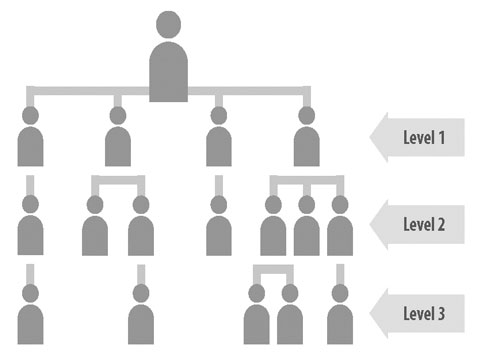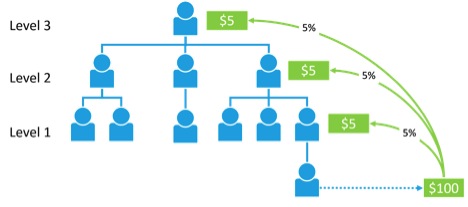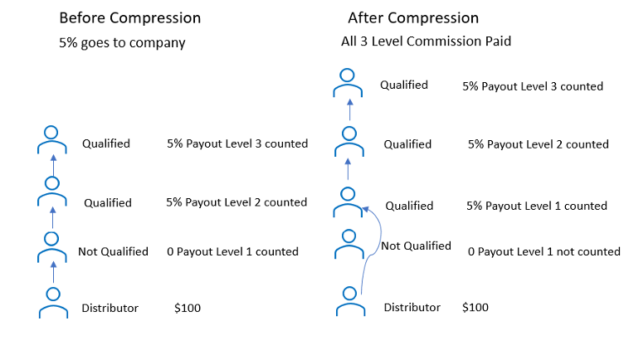SHARE
Understanding Multilevel Commissions: Compression

In the world of level commissions, compression is probably the most significant innovation. Around since about 1985, compression became so prevalent that it’s rare to see a level commission without compression.
What exactly is a level commission?
A variety of level commissions exist such as unilevel, matching, and generation/leader commissions. A level commission pays a percent on a number of levels. In our example, a distributor purchases a product for $100. The commission plan pays up 3 levels with 5% on each level.
However, what happens when someone is not qualified. Without compression, the level gets counted and not paid. In our example, if level 2 was not qualified and no compression exists then that commission amount does not get paid to anyone. The company keeps the commission, called breakage.
Before we get too far into compression, two forms exist, compression of volume and compression of commission payout. Compression of volume occurs when a distributor is qualified for a rank on three-level volume and one of those in the physical levels has no volume, then the next distributor in line with volume would count as the third level of volume.
In this article, we will cover compression of commission payout.
Commission Compression
Compression is a technique that keeps inactive or non-qualified distributors from occupying a payout level. For example, if I sponsor Maria and she doesn’t qualify to earn a level commission, I receive commissions on her first-level distributors as though I’d personally sponsored them. The process repeats until we find a qualified distributor that occupies the second level, and so forth (see Figure 1). This example portrays standard compression.
Compression solves a couple of problems. It puts more money into the hands of the distributor. It encourages distributors to work with their downlines, even those many levels of sponsorship down the genealogy. The commission program skips around their inactive or non-qualifying downline distributors. Compression leaves these inactive distributors in place and gives them time to build their organizations.
Before compression, companies took away a distributor’s rank or terminated the distributorship entirely if he or she was inactive for even a month or two. The no compression approach discouraged distributors struggling to build an organization. Today, most companies allow distributors non-qualifying months without taking away their rank or terminating them. The company doesn’t pay them for this rank, but it doesn’t punish them by taking away the rank. Companies with this type of system refer to two ranks, pin and paid. The pin rank records the highest rank the distributor has achieved. The paid rank record the rank the distributor qualifies to be paid in the current month.
Problem of Breakage
In addition, compression solves the problem of breakage. If a company doesn’t compress out non-qualified distributors, the unqualified distributors accumulate commissions. Since they don’t qualify, the company keeps the commission money. Breakage is the difference between what a company’s commission plan can pay and what it actually does pay. Most plans have some breakage. The problem with allowing breakage is that if a company is having a period of declining sales, then this type of breakage increases as a percentage of sales. When this happens, distributor checks go down faster than sales do. That is something no company wants.
Standard Compression
Standard compression rules indicate that we attempt to pay each level of the bonus a single time a distributor is qualified, then advance to the next level. Distributors in the upline who do not qualify for the bonus are compressed, but distributors who do qualify for the bonus, but not for the level, are not compressed.
The rules of standard compression say that a distributor compresses out if the distributor is inactive or non-qualified. A distributor who is active and qualified, but doesn’t qualify for fourth-or fifth-level commissions, won’t receive the commission for those levels; it becomes breakage.
Dynamic Compression
One challenge of dynamic compression is that the term “dynamic compression” can have several meanings. Every time I use it, people think of different things. In one company that implemented dynamic compression, the company executives thought it meant one thing, the field thought another thing, and the programmers thought another thing, and the brochure described something entirely different. It was in effect for over a year before the company executives realized that the programmers hadn’t programmed it as executives understood it.
Dynamic compression is a variation on compression. Standard compression, typically, doesn’t pay out all of the commission money. In standard compression, if a distributor qualifies on a level, but we paid that level, we count the level, and the compensation engine moves to the next qualified person. In standard compression, every qualified distributor counts as a level. Dynamic compression pays out all levels of a level commission.
Dynamic compression checks two aspects of each distributor upline from a sale, qualification and rank. We always start with a distributor or customer order and pay that upline. This may seem backward. However for understanding commission payout accurately, you must pay from the bottom (point of sale) up.
Dynamic compression compresses out not only those who are inactive or non-qualified; it also compresses out people who don’t qualify for a specific level of commission but are active. If a distributor is qualified, but not qualified to receive on level 4, then we would not count the level as been paid. In dynamic compression, we would go until we find a distributor who is qualified and at a rank that receives payout on level 4 and pay.
Advantage of Dynamic Compression
The advantage of dynamic compression is that it lets a company pay a leader even deeper into the downline. The disadvantage of dynamic compression is that if it’s challenging to qualify for a level, then distributors may be paid down many levels because few people in their downline are qualified. The result is that a company pays out a lot of money.
Another problem occurs when one day someone on such a distributor’s first level does qualify. All that income then moves to the distributor’s first level, causing a sudden and drastic downturn in earnings for that person.
In summary, we use compression in level commission to increase payout to the field and to encourage distributors to work with more people in their downlines.
you may also like
Essential Software Customizations for MLM, Direct Selling, and Affiliate E-commerce
Navigating the changing landscape of e-commerce, particularly within MLM, direct selling, and affiliate marketing channels, requires more…
How to Ensure Your Compensation Plan and Software Work Well Together
Peanut butter and jelly. Milk and cookies. Batman and Robin. Everybody knows these famous pairings work well…
Podcast 53: Advantages Using an Interim VP of Sales for Direct Selling Companies
Today we welcome a returning guest of this podcast: Jeff Jordan. Jeff has also written articles for…
compensation consulting for mlm companies
We offer data-driven compensation plan design & analysis
MLM.com Newsletter
Get our e-mail newsletter, with MLM.com articles & online exclusives, delivered to your inbox each week.





